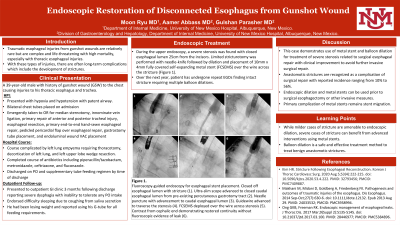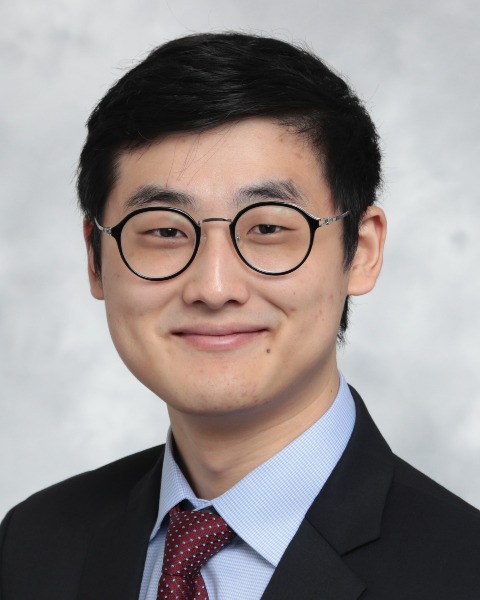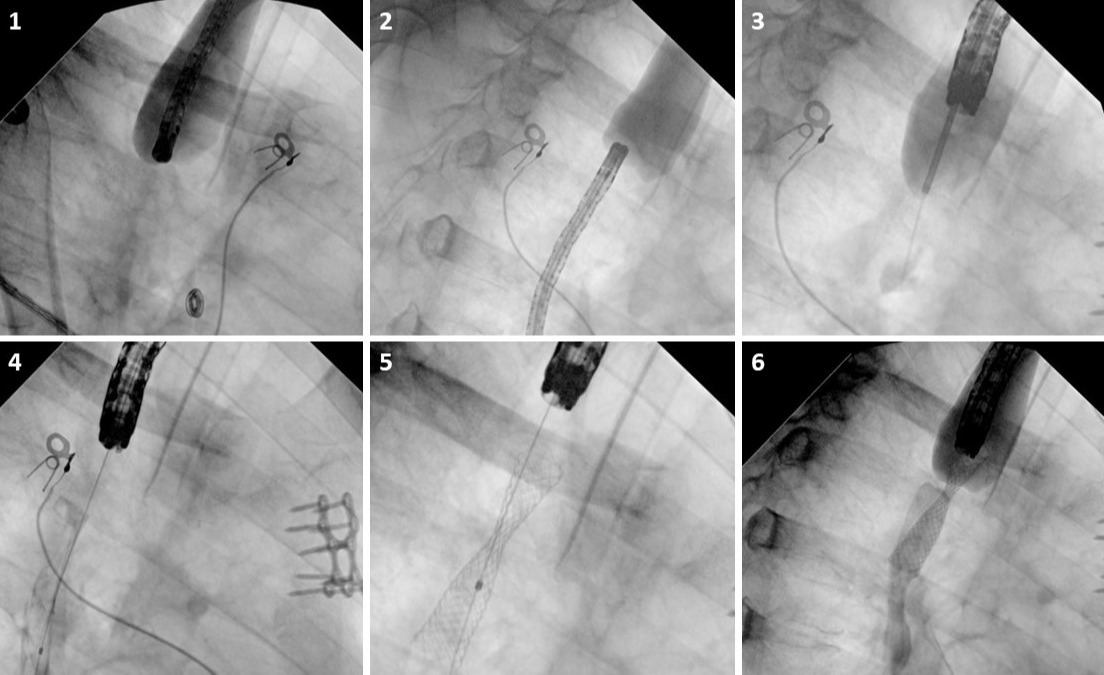Tuesday Poster Session
Category: Interventional Endoscopy
P3758 - Endoscopic Restoration of Disconnected Esophagus From Gunshot Wound
Tuesday, October 24, 2023
10:30 AM - 4:00 PM PT
Location: Exhibit Hall

Has Audio

Moon Ryu, MD
University of New Mexico Health Sciences Center
Albuquerque, NM
Presenting Author(s)
Moon Ryu, MD, Aamer Abbass, MD, Gulshan Parasher, MD
University of New Mexico Health Sciences Center, Albuquerque, NM
Introduction: Traumatic esophageal injuries from gunshot wounds are relatively rare but are complex and life-threatening with high mortality, especially with thoracic esophageal injuries. Beyond the immediate complications in the perioperative setting, there are long-term complications which include the development of strictures. In the below case, a patient with a recent history of gunshot wound with thoracic esophageal injuries is found to have complete stricture causing significant dysphagia.
Case Description/Methods: A 39-year-old male with history of gunshot wound to the chest causing injuries to his thoracic esophagus and trachea presented with persistent dysphagia and difficulty sleeping due to coughing from saliva secretion.
During the hospitalization for his gunshot wound, the patient had previously undergone emergent esophageal resection with primary end-to-end esophageal repair. A gastrostomy tube (G-tube) was placed prior to discharge.
On presentation to GI clinic, the patient reported severe dysphagia with inability to tolerate any PO intake. He used his G-tube for all feeding requirements. He was subsequently scheduled for EGD with assessment for procedural intervention.
During the upper endoscopy, a severe stenosis was found with closed esophageal lumen 25cm from the incisors. Advancement with guidewire was trialed and failed. Fluoroscopic contrast was injected with demonstration of closed esophageal lumen. Ultra-slim endoscope was passed through pre-existing gastrostomy site to caudal end of esophageal stricture with diaphragmatic stricture estimate of 1-2 cm in length. Therapeutic endoscope was re-advanced to cephalic end of stricture and needle puncture made using a 22-gauge endosonographic needle. Under fluoroscopic guidance, the needle was advanced to the caudal esophageal lumen. A guidewire was used to traverse the stricture. Limited stricturotomy was performed with needle-knife followed by dilation and placement of 10mm x 4mm fully covered self-expanding metal stent over the wire across the stricture. Fluoroscopic contrast was injected to visualize restored continuity with no evidence of leak.
Discussion: The above case demonstrates a known long-term complication of surgical repair following traumatic esophageal injury from gunshot wounds. While milder cases of stricture are amenable to endoscopic dilation, severe cases of stricture can benefit from advanced interventions using metal stents. These procedures can be used prior to surgical esophagectomy or other invasive measures.

Disclosures:
Moon Ryu, MD, Aamer Abbass, MD, Gulshan Parasher, MD. P3758 - Endoscopic Restoration of Disconnected Esophagus From Gunshot Wound, ACG 2023 Annual Scientific Meeting Abstracts. Vancouver, BC, Canada: American College of Gastroenterology.
University of New Mexico Health Sciences Center, Albuquerque, NM
Introduction: Traumatic esophageal injuries from gunshot wounds are relatively rare but are complex and life-threatening with high mortality, especially with thoracic esophageal injuries. Beyond the immediate complications in the perioperative setting, there are long-term complications which include the development of strictures. In the below case, a patient with a recent history of gunshot wound with thoracic esophageal injuries is found to have complete stricture causing significant dysphagia.
Case Description/Methods: A 39-year-old male with history of gunshot wound to the chest causing injuries to his thoracic esophagus and trachea presented with persistent dysphagia and difficulty sleeping due to coughing from saliva secretion.
During the hospitalization for his gunshot wound, the patient had previously undergone emergent esophageal resection with primary end-to-end esophageal repair. A gastrostomy tube (G-tube) was placed prior to discharge.
On presentation to GI clinic, the patient reported severe dysphagia with inability to tolerate any PO intake. He used his G-tube for all feeding requirements. He was subsequently scheduled for EGD with assessment for procedural intervention.
During the upper endoscopy, a severe stenosis was found with closed esophageal lumen 25cm from the incisors. Advancement with guidewire was trialed and failed. Fluoroscopic contrast was injected with demonstration of closed esophageal lumen. Ultra-slim endoscope was passed through pre-existing gastrostomy site to caudal end of esophageal stricture with diaphragmatic stricture estimate of 1-2 cm in length. Therapeutic endoscope was re-advanced to cephalic end of stricture and needle puncture made using a 22-gauge endosonographic needle. Under fluoroscopic guidance, the needle was advanced to the caudal esophageal lumen. A guidewire was used to traverse the stricture. Limited stricturotomy was performed with needle-knife followed by dilation and placement of 10mm x 4mm fully covered self-expanding metal stent over the wire across the stricture. Fluoroscopic contrast was injected to visualize restored continuity with no evidence of leak.
Discussion: The above case demonstrates a known long-term complication of surgical repair following traumatic esophageal injury from gunshot wounds. While milder cases of stricture are amenable to endoscopic dilation, severe cases of stricture can benefit from advanced interventions using metal stents. These procedures can be used prior to surgical esophagectomy or other invasive measures.

Figure: Fluoroscopy-guided endoscopy for esophageal stent placement. Closed off esophageal lumen with diaphragmatic stricture (1). Ultra-slim scope advanced to closed caudal esophageal lumen from pre-existing percutaneous gastrotomy tract (2). Needle puncture with advancement to caudal esophageal lumen (3). Guidewire advanced to traverse the stenosis (4). Fully covered self-expanding metal biliary stent deployed over the wire across stenosis (5). Contrast from cephalic end demonstrating restored continuity without fluoroscopic evidence of leak (6).
Disclosures:
Moon Ryu indicated no relevant financial relationships.
Aamer Abbass indicated no relevant financial relationships.
Gulshan Parasher indicated no relevant financial relationships.
Moon Ryu, MD, Aamer Abbass, MD, Gulshan Parasher, MD. P3758 - Endoscopic Restoration of Disconnected Esophagus From Gunshot Wound, ACG 2023 Annual Scientific Meeting Abstracts. Vancouver, BC, Canada: American College of Gastroenterology.
